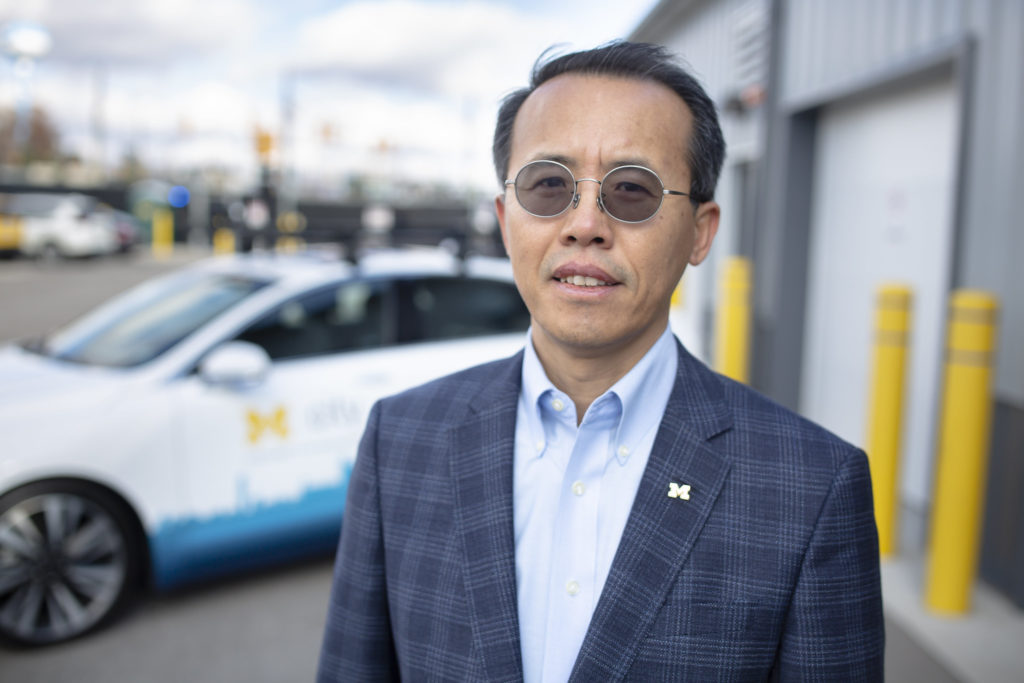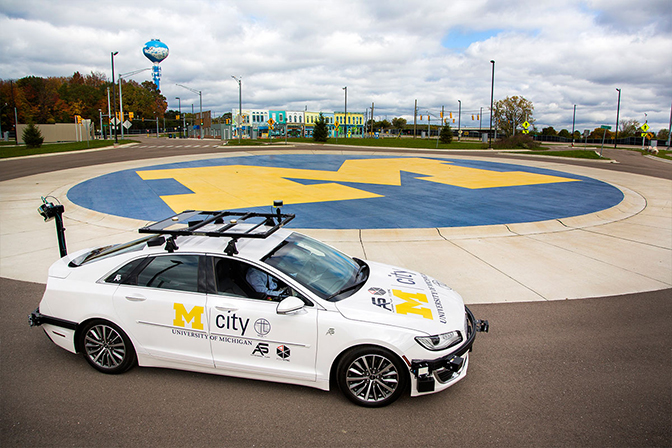
Q&A with Henry Liu, Mcity’s new director
University of Michigan’s mobility research center has been realigned under Michigan Engineering.

University of Michigan’s mobility research center has been realigned under Michigan Engineering.
Mcity, a public-private mobility research partnership to advance transportation safety, sustainability, equity and accessibility is starting the new year with new leadership.
Henry Liu, a U-M professor of civil and environmental engineering who has been involved with Mcity since it was still on the drawing board, officially took over the director’s role Jan. 1. His vision includes deepening the focus on access and equity as well as expanding the collection and use of mobility data to guide solutions, and drawing more disciplines from across campus into Mcity’s work.
Liu succeeds Huei Peng, the Roger L. McCarthy Professor of Mechanical Engineering, who has been director for the last five years of Mcity’s eight-year history. In addition to the leadership change, Mcity’s administrative home is now U-M’s Office of the Vice President for Research (OVPR) to become a part of Michigan Engineering.

As Mcity embarks on its next phase, Liu, who is also research professor at the U-M Transportation Research Institute and director of the Center for Connected and Automated Transportation, sat down to discuss the road ahead.
Mcity is best known as a test track—the world’s first purpose-built test environment for connected and autonomous vehicles (CAVs) and technologies. But that test facility is just one element of the public-private partnership initially known as U-M’s Mobility Transformation Center (MTC). The facility was visionary when it opened in 2015 because there were so many resources being thrown at the vehicle technology, but nowhere to really put those vehicles to the test. We drew a lot of visitors in the early years to the point where, now, you can find tracks modeled on Mcity all over the world.
Since then, under Huei Peng’s leadership, we’ve rebranded MTC as Mcity and we’ve grown into the full-fledged research partnership envisioned when MTC launched in 2013. We remain the best-equipped and most innovative test environment for those vehicles. And we bring together partners from the public, private and academic sectors and connect them to discuss common, pre-competitive issues related to CAV deployment and adoption.

If you think of a competition as a game, you need to define the rules of the game before you can play. Pre-competitive issues are essentially the rules that automakers, cities and other stakeholders must develop and agree to. For instance, we need well-defined safety standards for automated vehicles. Mcity has proven to be a venue where these stakeholders can discuss pre-competitive challenges and also partner to educate and influence policy-makers.
My top priority is remaining a trusted public-private partnership—a place that can offer common ground to a host of stakeholders that, in some cases, usually compete with each other.
An area for growth is engaging U-M’s full range of expertise to address mobility beyond development of new technology. We must draw on a convergence of disciplines to study how the technology is used, for example, and how it impacts people.
We want to look into the mobility needs of disadvantaged communities as well. How can new mobility technologies be incorporated into their daily activities? How can they benefit in a tangible way? For some people, access to new mobility options and technologies is nonexistent. We want to better understand transportation equity issues. How can we position mobility advances to best help those who most need them?
We also plan to create what I call a Mobility Data Center. Through one of our current research projects, we’ve equipped 21 traffic intersections in Ann Arbor—our living laboratory—to gather and transmit vehicle safety and performance data in real time to connected vehicles. Our objective is to help demonstrate the safety potential of CAVs. That’s just one of many data collection projects underway.
We will provide access to the Mobility Data Center to our Leadership Circle companies as they seek to facilitate the deployment of automated vehicles.
The University of Michigan’s core mission is education, as well as research. We are one of the leading universities in connected and automated vehicles. And as such, we’re positioned to help train and grow the engineers who can impact this space.

There is a gap right now between what graduates are trained for and what’s needed right now in the mobility industry workforce. Together with the Department of Civil and Environmental Engineering, Integrative Systems and Design (ISD), as well as the University of Michigan Transportation Research Institute (UMTRI), we are in the planning process to develop stackable credentials on mobility, including graduate certificates and master’s of engineering degrees.
It allows us to better serve the university mission, particularly in regard to education. You can see that in the development of the certificate and masters programs. We should see increased collaborations with entities like the UMTRI or departments like Civil and Environmental Engineering.
At the same time, as a public-private partnership, we have a number of government and industry partners working with us. There is potential there for providing unique education opportunities for our students.
That’s not to say everything we do as a part of Michigan Engineering will be engineering-centric. This change positions us to work with all different areas of the university doing work that is truly multidisciplinary. By drawing on all of the expertise we have on hand at U-M, we can realize the full potential of what Mcity was set up to be from the very beginning.